DPWX/Overshooting thunderstorm top: 4 June 2015
Authors: Patrick C. Kennedy and Stanley Q. Kidder
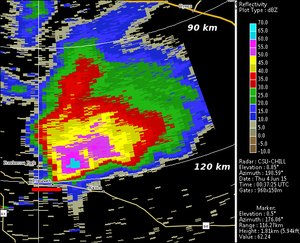
Low elevation angle reflectivity data collected by the CSU-CHILL radar from a severe thunderstorm located near Elizabeth, Colorado (red underbar) at 0038 UTC on 4 June 2015. The overshooting top activity that occurred in the upper levels of this thunderstorm have been documented using plots of radar and GOES satellite data.
Overview
Several thunderstorms were active in the CSU-CHILL radar coverage area around 00 UTC on 4 June 2015. The most intense storm was in the vicinity of Elizabeth, Colorado at a range of ~100 km from CHILL. Due to the beam curvature effects at this long range, CHILL radar observations at near surface heights were compromised. Data collected at the storm top / anvil cloud level contained the patterns of intense divergence and overshooting cloud tops that are associated with strong updrafts. The following 0.5 degree angle PPI scan shows the storm's location at 0008:33 UTC:
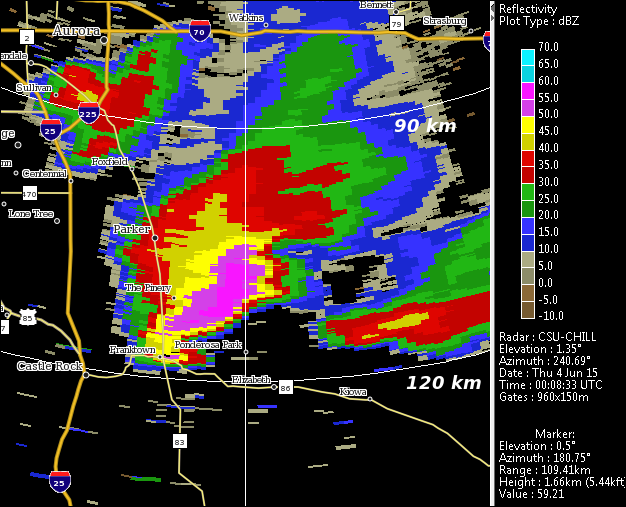
Echo configuration near 0010 UTC
The range to the Elizabeth storm from the NWS KFTG (Denver) radar was only ~ 50 km, allowing this radar to more completely survey the echo system. The following plot shows a 3D rendering of the storm's structure generated by the GR2analyst software package from the KFTG 004:08 volume scan. In this plot the storm is being viewed from its western side. The strong updraft associated with the echo core locally elevated the echo summit into an overshooting top that projected above the anvil's upper surface.
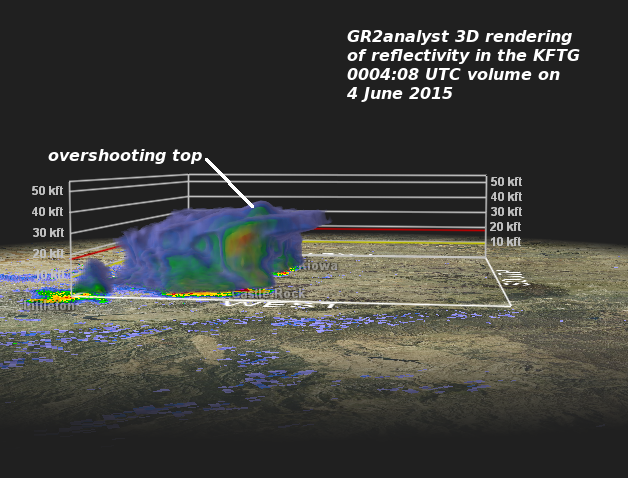
Approximately 8 minutes later, the CSU-CHILL radar conducted an RHI scan that intercepted the overshooting top. The radial velocity pattern in the overshooting top (negative / inbound velocities on the near-range side and positive / outbound velocities on the far-range side) depicts strong divergence driven by the updraft's interaction with the increased static stability at the tropopause. The > 20 mps magnitude mid-level inflow on the storm's southern edge and the overhanging reflectivity configuration in the RHI plane also indicate that the storm contained a strong updraft.
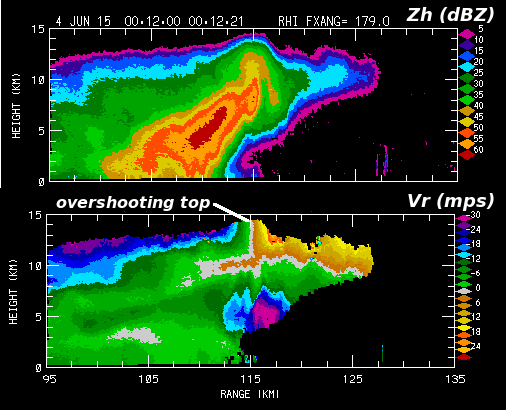
Echo configuration near 0045 UTC
The storm remained intense throughout the 00 UTC hour; hail as large as 2.5 inches in diameter was reported 3 miles ENE of Elizabeth at 0042 UTC. The following 3D rendering was generated from the 0045:23 UTC KFTG volume scan. The maximum echo top heights continued to occur in a region that curved around the storm's southwestern edge.
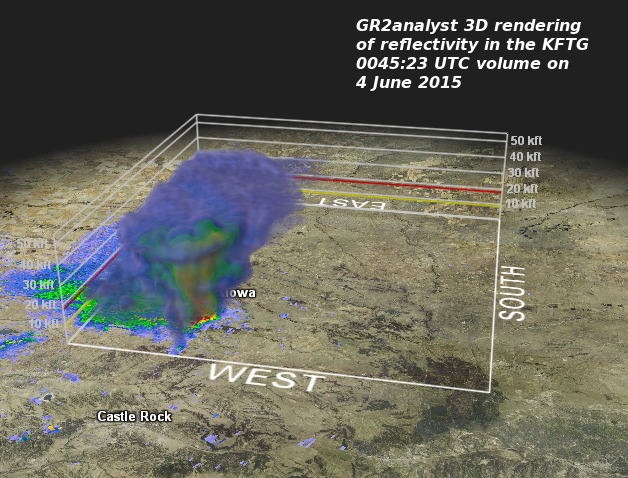
The next two plots show the reflectivity and radial velocity patterns in the 12.5 degree elevation angle sweep of the KFTG 0045:23 UTC volume scan. The general "kidney bean" shape of the echo within the 30 dBZ (bright green) reflectivity region suggests that the horizontal airflow is locally accelerated as the air passes the echo core and enters the downstream anvil.
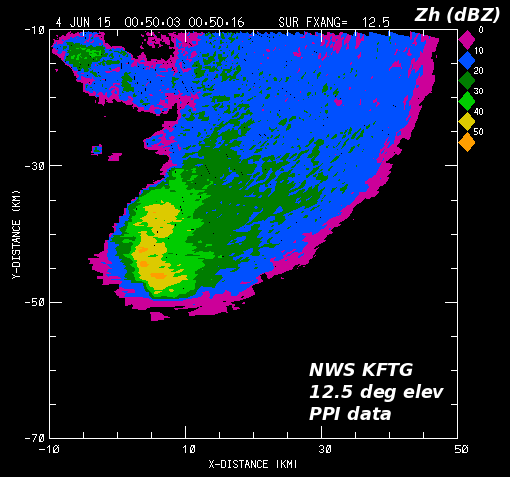
The KFTG 12.5 deg elevation angle PPI sweep captured the divergent radial velocity pattern in the upper levels of the storm.
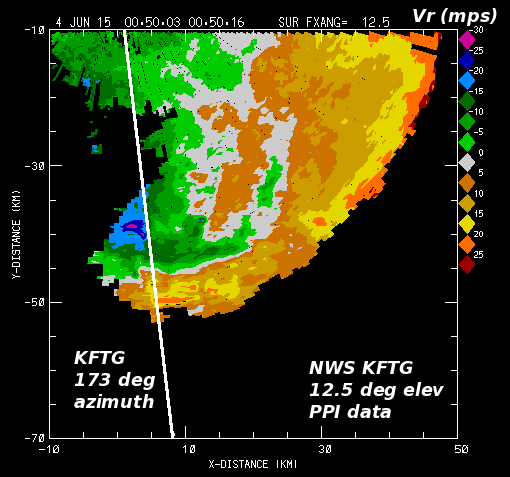
A more detailed view of the storm's vertical structure was obtained in a CSU-CHILL RHI scan done at 0040 UTC. The overhanging echo configuration continued to be present.
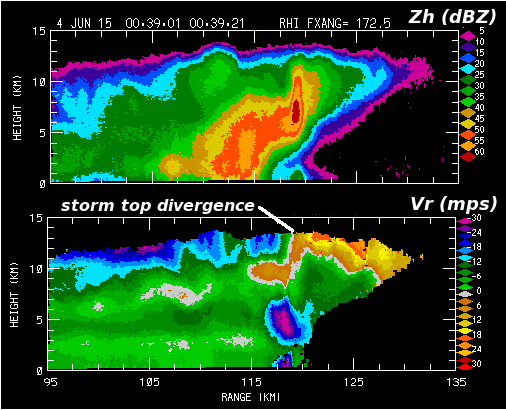
While the overshooting top echo was less evident on the CHILL 0040 UTC RHI, the GOES East visible satellite image from a scan that began at 0045 UTC showed considerable overshooting activity in the southwestern portion of the anvil. (The green line marks the approximate location of the RHI shown above.)
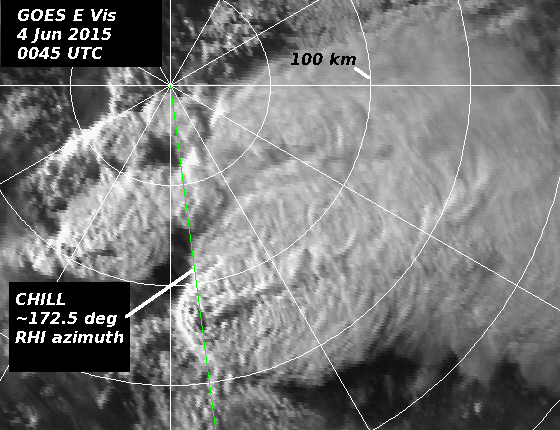
The next plot is the corresponding GOES IR image. The temperature pattern across the anvil has the V notch configuration with a relatively warm region immediately downstream from the overshooting activity near the southwestern end of the storm. Detection of the V notch pattern has been correlated with severe thunderstorms [McCann, 1983]
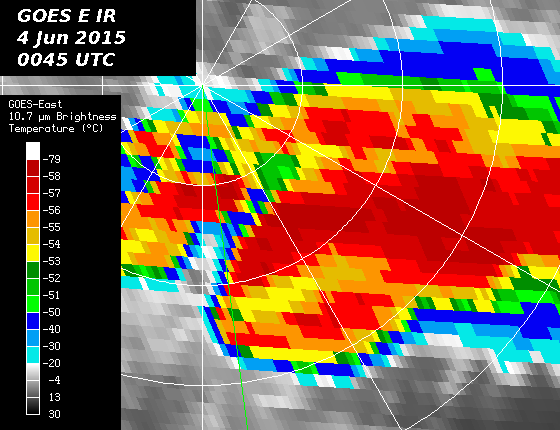
The time evolution of these satellite features is shown in the following two GOES image loops (visible and IR) covering the period from 2200 UTC on 3 June through 0145 UTC on 4 June 2015:
|
|
||
|
|
|
||
|
Northern Colorado Lightning Mapping Array data
The radar and satellite data indicate that strong updrafts existed in the Elizabeth storm around 0045 UTC. The high supercooled liquid water concentrations developed by these updrafts were a significant factor in the growth of the large hail that was observed at the surface. This vigorous updraft / mixed phase cloud environment also promoted electrical charge separation and lightning activity. The final plot shows the spatial concentration of lightning-related VHF electrical discharges recorded by the Northern Colorado Lightning Mapping Array (LMA) LMA during the 0040 - 0050 UTC period. High discharge concentrations (white colors) were detected at heights reaching ~15 km MSL in the storm. The horizontal distribution of this concentrated discharge activity showed a pattern that curved around the main updraft. This configuration was probably due to the stream of ice particles that became positively charged through the non-inductive charging process in the updraft and were then swept into the anvil.
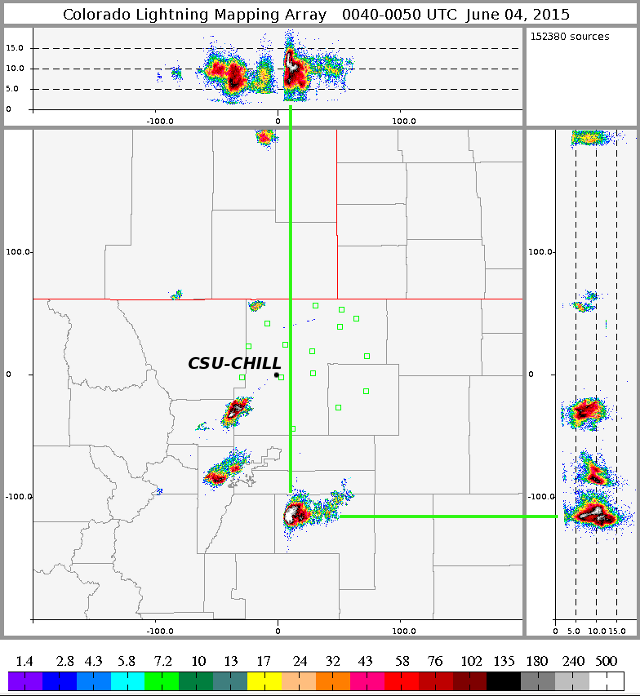
References
- [*McCann, 1983] Donald W. McCann, 1983: The Enhanced-V: A Satellite Observable Severe Storm Signature. Mon. Wea. Rev., 111, 887–894.

